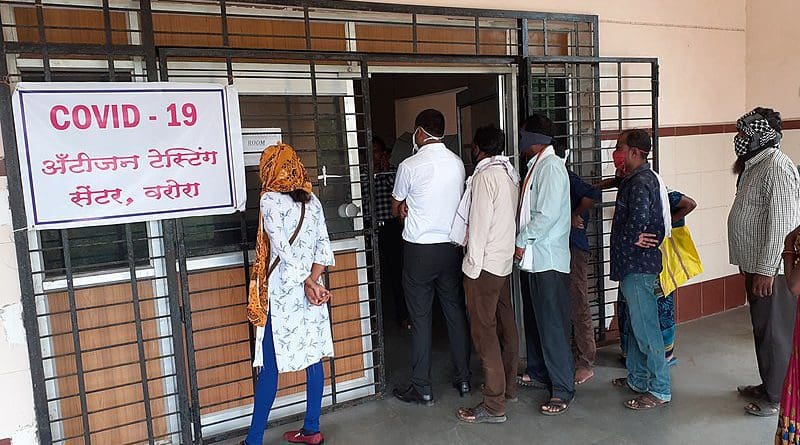Key Lessons From India On COVID-19 Vaccination – Analysis
By Chandrakant Lahariya*
With the global spread of the COVID-19 Delta variant, it is clear that the fate of the world, even in countries with high vaccination coverage, is interlinked with every person on the planet. But global health leaders and communities seem to be learning slowly. The race to administer vaccines with a continued prioritisation of domestic needs — while many more in low-income countries are left waiting for their first shots — is telling.
The COVAX initiative led by the World Health Organization (WHO) and others to make vaccines available for low- and middle-income countries depends largely upon vaccine manufacturers in India. The very first shot channelled through COVAX was manufactured in India, and the country initially exported more doses than it administered at home. But the onset of India’s ferocious second wave led it to implement a ‘temporary’ ban on exports of COVID-19 vaccines that continues to this day.
This measure had its origin in many avoidable miscalculations. India’s goal is to fully vaccinate its adult population of 940 million by December 2021. After initially struggling with low uptake and widespread hesitancy, the country implemented a series of policies aimed at boosting demand and increasing coverage. This included opening COVID-19 vaccination to everyone above 18 years of age, resulting in a threefold increase in target beneficiaries.
Meanwhile, poor planning left vaccine supply largely unchanged. Changes in vaccine procurement policy made state governments responsible for purchasing 25 per cent of total available vaccines, reducing the number of available vaccines just as they were needed most. By 31 July, India had administered 470 million doses of COVID-19 vaccines, which meant 7.5 per cent of the total population was fully vaccinated and 19 per cent partially vaccinated. To achieve its target, India needs to administer 10 million shots per day, twice of the current rate of 5 million shots per day.
The global challenge of vaccine availability has become more urgent given the alarming transmissibility of the Delta variant. A new wave of infections is sweeping Africa and Asia, where many health workers remain unvaccinated.
The Indian government has developed a plan to ramp up vaccine production and availability in the months ahead, and it is projected that around 1.35 billion doses will be available between August and December 2021. Operational challenges and a return of vaccine hesitancy mean India’s vaccine supply may exceed demand by October. This may increase the number of shots available for export to COVAX and other global stakeholders.
The licensing and authorisation of 19 COVID-19 vaccines worldwide in just 19 months is a ground-breaking achievement, yet the inequity in their global distribution highlights serious failures in global cooperation. Many high-income countries have secured enough COVID-19 vaccines to vaccinate three- to five-fold their population. The efforts of the WHO and other international partners have produced only partial success in ensuring vaccine equity, and the challenges will only deepen as rich countries seek to administer booster doses.
Though many challenges were unforeseen, a lack of timely planning and execution — both at global and multilateral levels — has complicated the situation. In March 2021, a meeting of the Quadrilateral Security Dialogue rightly identified the need for collaboration between Australia, the United States, Japan and India to ensure increased access to COVID-19 vaccines. But their intended timeline was as late as the last quarter of 2022. It was only after the Delta variant began rapidly spreading that these targets were shifted to the last quarter of 2021.
In June 2021, the G7 pledged to donate 1 billion doses to COVAX. This is only a fraction of the 11 billion doses the world needs to ensure vaccine equity — a good start but not enough, and a reminder that the global community needs to move beyond symbolism.
In October 2020, South Africa and India floated a proposal for temporary intellectual property waivers for COVID-19 vaccines in the World Trade Organization. This led to renewed discourse on compulsory and voluntary licensing, receiving a boost after the United States agreed to support a related proposal. While such measures could pave the way for future collaboration, they will have few immediate benefits. Other mechanisms such as the WHO’s COVID-19 Technology Access Pool have received no takers.
While there have always been discussions about the need for global solidarity to fight pandemics, the world has once again faltered in coming together to tackle COVID-19. Vaccine-manufacturing countries continue to prioritise shots for their citizens before sharing them globally.
There is enough evidence that active collaboration and strong partnerships are crucial — hopefully the global community will soon take note.
*About the author: Dr Chandrakant Lahariya, a physician-epidemiologist, is a public policy and health systems expert, based in New Delhi, India. He is the lead co-author of ‘Till We Win: India’s Fight Against The COVID-19 Pandemic’ (Penguin Random House India 2020).
Source: This article was published by East Asia Forum

